
The Comptroller's Report:
Connecticut's Economic Health
|

|
|
February 2002
|
Nancy Wyman, State Comptroller
|
Dear
Fellow
Citizens,
As the state's chief fiscal guardian and an independent voice
for taxpayers, I am proud to present this unique issue of The
Comptroller's Report: Connecticut's Economic Health. |
 |
|
Nancy Wyman, State Comptroller |
This annual report is designed to give you a common sense view of our state's
fiscal condition and outlook for the future. It can also help citizens hold
government accountable by showing them where their hard earned tax dollars are
being spent.
By Constitutional authority, the Comptroller is the state's accountant and
payroll officer. I also procure and administer the health care plan for all
state employees, retirees and their dependents. Therefore, I am constantly
looking for ways to make government spending more efficient, and to improve the
quality and cost of health care for all residents.
Like many of you, I am a member of the so-called "sandwich
generation." I know well the pressures many of us experience caring for our
children, grandchildren and aging parents - all at the same time. That is why it
is so important to me that Connecticut continues to invest in our future. In
particular, home care, day care and long-term health care services must be
enhanced. I believe these programs not only improve peoples' lives, but can save
tax dollars.
Government also must continue to explore ways to rein in the soaring costs of
prescription drugs. We should find ways to use the state's enormous buying power
to drive down the price and increase the accessibility of medications to the
consumer.
Helping small businesses thrive has been a priority for me since I was first
elected seven years ago. This year, I plan to ask the General Assembly to allow
small businesses to buy into the state's Municipal Employees Health Insurance
Program. That initiative could help businesses offer vital health insurance
benefits to their workers, at no cost to taxpayers.
In this time of rapid economic change, efficiency is paramount. Government,
like its citizens, must do more with less. Trying to save money by blindly
cutting programs that work, however, makes no sense. A more practical approach
is to figure out what programs are not delivering and make targeted,
cost-effective cuts.
The tools to make those kinds of decisions will be put into policymakers'
hands through the ongoing revamping of our state's core financial computer
systems. This enormous, collaborative project, known as CORE-CT, represents a
radical change in the way the state does business. Most importantly, it will for
the first time enable the state to track every tax dollar that is spent so that
intelligent budget cuts can be made without damaging effective programs.
The state also must become a better business partner to the towns and cities
of Connecticut. We can take a step toward that goal by increasing the savings in
our emergency Rainy Day Fund so that we are able to deal with inevitable
economic downturns that affect every municipality. As I proposed last year, the
state should also reinvest the interest earned on the Rainy Day Fund by sharing
it with the towns and cities in order to help them avoid local tax increases.
Finally, I will continue to fight for the state to adopt Generally Accepted
Accounting Principles. This accounting and reporting method presents a much more
honest picture of state finances than the current practice, which allows for
distortion and manipulation of the state's receipts and expenditures.
I am hopeful that you will find this report informative and that it
encourages you to participate in the democratic process that affects every
citizen of Connecticut.
Sincerely,
Nancy Wyman
State Comptroller
P.S. - If you would like to receive updated information on Connecticut's
economy throughout the year, be sure to sign up for our E-mail updates at http://osc.ct.gov/public/listserv/
or visit my website at osc.ct.gov
Connecticut's Workers Among Most Productive in Nation
Diverse, Well-Educated Workforce Poises State for Economic
Recovery
With one of the most productive and diverse workforces in the nation,
Connecticut is well positioned to resume a course of economic expansion.
According to the Connecticut Department of Labor, worker productivity in the
state is 23 percent above the national average. The state's workforce is highly
educated and well trained. Connecticut ranks third nationally in the percent of
population over age 25 who hold a bachelors degree or higher.
This robust level of productivity and advanced education results in high
wages. Connecticut ranks first in the nation in average annual pay, with an
average salary of over $45,000.
The state's industrial base with its 93,000 business establishments has
diversified over the last decade. While defense and insurance continue to be
important industries, the state's economic development is increasingly tied to
industries such as bioscience, software development, pharmaceuticals,
communications and medical technology.
A federal Department of Labor survey put the number of high-tech workers in
the state at 77,500 in 2000, up 23 percent from 1994. Connecticut ranks fifth
among all states in the percentage of workers employed in technology
occupations.
Connecticut also benefits economically from its geography, especially its
location between the financial centers of Boston and New York. More than one
quarter of the total population of the United States and 60 percent of the
Canadian population lives within 500 miles of Connecticut. Over 30 percent of
the nation's effective buying income, retail sales, and manufacturing firms are
within a day's drive of the state.
Connecticut has an extensive network of expressways and arterial highways
providing access to regional markets. In 2001 the state legislature made a major
financial commitment to reducing congestion on the state's roads and highways.
Bradley International Airport is strategically situated for overseas airfreight
operations and has been continually upgraded to keep pace with service needs.
Connecticut provides financial assistance to all urban and rural bus services
operating in the state. Railroad freight service is provided to most major towns
and cities in the state, and connections are provided with major eastern
railroads and Canadian markets. Rail commuter service operates between New Haven
and New York City and connecting points, as well as between New London and New
Haven. The state's harbors at Bridgeport, New Haven and New London can
accommodate deep draft vessels.
Still, Connecticut's economy moves in the same general cycles as the national
economy. At times, the state is ahead of national economic trends, at times we
lag behind. As of this writing, Connecticut and the nation were moving through a
period of economic recession.
According to preliminary estimates by the Bureau of Economic Analysis, Real
Gross Domestic Product (GDP), which measures the output of goods and services
produced in the United States, declined in the third quarter of 2001. This comes
after virtually no growth in GDP in the second quarter. Over the last five
years, real GDP had expanded at an average annual rate of just over 4 percent.
The National Bureau of Economic Research (NBER), a nonprofit, nonpartisan
research organization that studies peaks and troughs in the business cycle,
declared in November 2001 that the country had entered into recession in March
2001. This marked the end of a historic ten-year period of economic expansion.
On a positive note, the NBER stated: "Expansion is the normal state of the
economy; most recessions are brief and they have been rare in recent
decades."
The information that follows in this section examines Connecticut's economic
life: where we work, what we earn, and how we spend our income. It shows a
fundamentally prosperous economy that is struggling through a current period of
recession but is poised to resume its historic pattern of strong growth.
Employment
- During the last recession, which ran from February 1989 to December of
1992 in Connecticut, the state lost 158,200 jobs (about 10 percent of total
payroll jobs averaged for the period). The recession hit Connecticut harder
than the nation in its duration and depth.
- From the beginning of the recovery in December 1992 through October 2001,
the state added 163,100 payroll jobs. A net gain of 4,900 jobs since the
last recession. The current slowdown is eroding this number.
- The rate of job additions in Connecticut continues to lag behind the rest
of the nation. This is due in part to stagnation in the state's pool of
available workers. Since 1995, Connecticut's workforce has increased just
0.4 percent as compared to a national growth rate for the period of 7.3
percent. The slow growth in the number of people seeking work in Connecticut
also helps to explain the state's low unemployment rate, recorded at 3.2
percent in October.
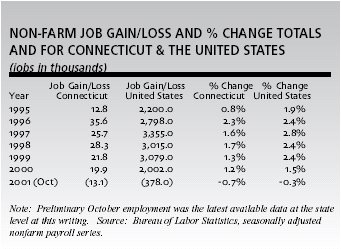
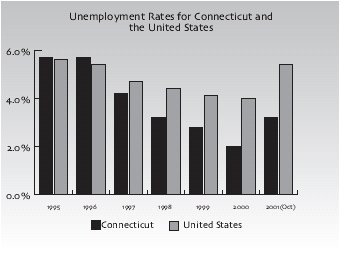
- Labor surplus areas, as designated by the federal government, have average
unemployment rates that are at least 20 percent higher than the average
unemployment rate for all states. Through September 2001, Connecticut had
four towns designated labor surplus areas: Bridgeport, Hartford, Killingly,
and Voluntown. This is down from 21 towns in 1997 and 1998.
- According to the Connecticut Department of Labor, in 2000 the state had
109,000 workers holding more than one job. This represents 6.5 percent of
employed state residents and is up from 5.9 percent in 1999. Nationally, the
number of multiple jobholders declined between 1999 and 2000 from 5.8
percent to 5.6 percent.
- Over the past 10 years there has been a dramatic change in the industries
in which Connecticut workers are employed. Manufacturing has been and
continues to be in decline. Manufacturing has slipped from employing 20.7
percent of state workers in 1991 to 15 percent in 2001. During the same
period, jobs in the service industry grew from 27 percent to 32 percent of
total employment. While the service industry does include some low skill,
low pay occupations it also includes engineering and management services,
technology and advance business services, health care, and educational services.
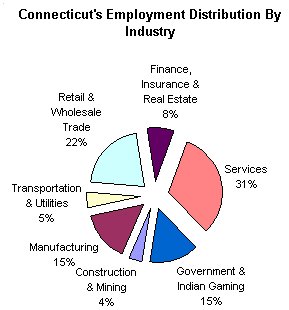
- The Connecticut Labor Department reports that five of the fastest growing
occupations in the state are in the computer technology field. Other fast
growing occupations include: social/human services assistant, medical
assistant, biological scientist, paralegal, and financial sales. Slow growth
is reported in jobs relating to textiles, printing, and machine operations.
Income
- Connecticut leads the nation in per capita income at $40,870 for 2000.
Connecticut's per capita income is 38.8 percent higher than that of the
nation. It should be noted that per capita and total personal income figures
as reported by the Bureau of Economic Analysis do not include income from
capital gains.
Per Capita Personal Income
for Connecticut and the United States
and
Connecticut's Comparative Advantage
| Year |
Connecticut |
United States |
% Above The
United States |
| 1995 |
$31,423 |
$23,272 |
35.0% |
| 1996 |
$32,814 |
$24,286 |
35.1% |
| 1997 |
$34,803 |
$25,427 |
36.9% |
| 1998 |
$37,190 |
$26,909 |
38.2% |
| 1999 |
$38,506 |
$27,859 |
38.2% |
| 2000 |
$40,870 |
$29,451 |
38.8% |
|
|
|
|
| SOURCE: Bureau of Economic Analysis, 10/19/01 release |
- Like the nation, Connecticut has experienced strong personal income growth
since 1995. The average annual growth rate from 1995 through 2000 was 5.7
percent in Connecticut and 5.9 percent for the United States.
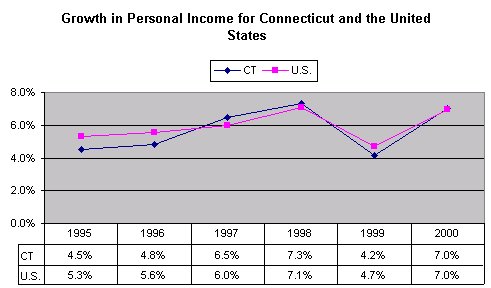
- Personal income is a good indicator of the increase in total state wealth,
but it tells little about how that wealth is distributed among Connecticut's
residents. That is, a state could have every dollar of wealth held in a few
hands and still lead the nation in per capita income. Median income provides
a somewhat better measure of wealth for the average state family.
- Connecticut has the fourth highest real (inflation adjusted) median
household income in the country, ranking behind Maryland, Alaska, and New
Jersey.
- To analyze changes in median income the Census Bureau recommends using a
two- year moving average to smooth any fluctuations caused by sampling
errors. For the 1999-2000 period real median household income in Connecticut
was $51,423, which is 22 percent above the national figure.
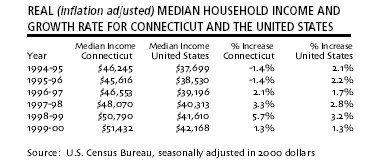
- Through the early and mid 1990's, real median household income in the
state was in decline. This trend was reversed in 1996-97, and since that
time the state has seen real median income growth.
- According to the Connecticut Department of Labor, the ten highest paying
occupations in the state are as follows: physician; dentist; chiropractor;
law teachers; judges and magistrates; financial sales agents; optometrists;
lawyers; engineering; information technology and science managers; and
podiatrists.
- Despite Connecticut's high overall income level; areas of regional poverty
remain a problem. Hartford and New Haven counties have traditionally posted
poverty rates that are approximately 20 percent higher than the state
average. The Census Bureau has reported the state's three-year average
poverty rate for 1998-2000 at 7.6 percent. The national average was 11.9
percent.
Other Economic Measures
- According to statistics from the Connecticut Department of Revenue
Services, over the past five fiscal years retail trade sales in the state
have increased at an average annual rate of 6.1 percent. Durable goods
expanded at a 7.1 percent rate, while non-durable goods grew 5.5 percent.
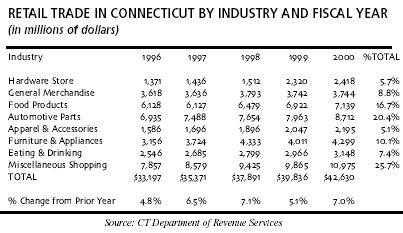
- Based on sales tax receipts for the current year, it is clear that the
recession is having a major impact on retail sales in the state. After three
years of average annualized growth of 4.1 percent in the sales tax, current
projections show virtually no growth for Fiscal Year 2002.
- Connecticut's export sector is playing an important role in the state's
economy. From 1995 through 2000, the state's export of goods grew at an
average annual rate of 5.9 percent. Transportation is the largest single
export component comprising 38.1 percent of exports in 2000.
- The Census Bureau reports that Connecticut's housing stock has increased
4.9 percent between 1990 and 2000. During this same period, population grew
3.6 percent. The state has 1,385,975 housing units. Owner occupied housing
comprises 66.8 percent of the total and the occupancy rate is 93.9 percent.
According to the National Realtors Association, on average Connecticut
families had 138 percent of the income required to buy an averaged priced
single family home. This is 8 percent higher than the national average. The
data suggest that housing in Connecticut is still a good long-term
investment.
Connecticut's Financial Position:
From Deficit to Surplus and Back Again
Connecticut state government uses two different accounting methods to assess
and report its fiscal condition. One method is referred to as Generally Accepted
Accounting Principles (GAAP); the other is known as modified cash accounting.
GAAP, as the name implies, is the recognized standard for accurate financial
reporting. Corporate financial reports that many readers are familiar with are
based on GAAP.
Connecticut state government has not yet adopted GAAP for budget or financial
control purposes. Instead the state uses the modified cash system to prepare the
budget and to control and report spending and receipts through the year.
The state's fiscal condition under modified cash accounting is dependent on
relatively unsystematic timing of payments and posting of receipts. GAAP
utilizes more rigid standards on when to post expenditures and record revenue.
Therefore, GAAP provides a more consistent and reliable method for reporting and
analyzing state financial data. Accordingly, the fiscal data that follows is
presented on a GAAP basis.
Because the state budget is presently based on modified cash accounting, the
media tends to report the state's position on this cash basis. Therefore, the
GAAP numbers that follow may surprise some readers.
Fiscal Year 2001 General Fund Performance -
Operating Results for One State Fund in a Single Fiscal Year
(July 1, 2000 - June 30, 2001)
- The General Fund is the state's largest single operating fund. Most state
programs and revenues are accounted for within the General Fund. Almost 90
percent of all state operating expenses are within this single fund.
- In Fiscal Year 2001, the state recorded a General Fund surplus of $13
million with revenues totaling $13.066 billion and expenditures of $13.053
billion. The surplus is equal to less than one-tenth of 1 percent of
expenditures.
- Since the introduction of the income tax in Fiscal Year 1992, the state's
cumulative General Fund surpluses total to $769 million.
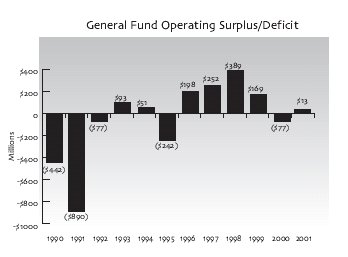
- At the end of Fiscal Year 2001 the sum of $30.7 million was placed in the
state's Rainy Day Fund bringing the fund balance to $594.7 million. This
fund is targeted to hold reserves equal to 5 percent of budgeted General
Fund spending for the year. In 1987, the Rainy Day Fund had a balance of
$319.6 million. Three consecutive fiscal years of withdrawals between 1988
and 1990 wiped the fund out.
- With no available Rainy Day Fund reserves by 1991 and a deepening
recession, the state was forced to borrow close to $1 billion in order to
close a budget hole. An expanded revenue base with the introduction of the
income tax in Fiscal Year 1992 and a gradually improving economy allowed the
state to pay off this debt over the six years that followed. Deposits to the
Rainy Day Fund have been made annually since 1995.
- Today, the state's revenue base, dollar reserves, and economic potential
are in a far stronger position than in the early 1990s.
General Fund Revenues:
- In Fiscal Year 2001, total General Fund revenue grew 5.9 percent or $730
million over the prior year. The income tax and the sales tax, which totaled
$7.3 billion in Fiscal Year 2001 and accounted for well over half of all
revenue, increased by 11.4 percent and 0.4 percent respectively from the
prior year.
- The current economic recession began in March 2001, which impacted the
final quarter of Fiscal Year 2001. The downturn reduced sales tax receipts
toward the end of the fiscal year. Income tax receipts were not impacted as
quickly or as severely by the recent downturn.
- Tax reductions over the past six years have reduced revenue by over $1
billion. The tax reductions have been broad based including direct rebates,
lower income tax rates at various income levels, a property tax credit,
substantial reductions in corporation taxes, additional sales tax
exemptions, and hospital tax relief.
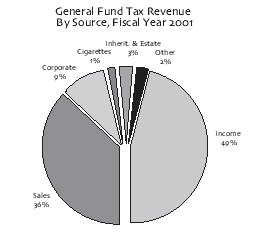
- Not all General Fund revenue comes from taxes. Taxes accounted for 66
percent of the total. Federal payments to the state contributed another 24
percent. The remaining 10 percent of General Fund revenues consisted of
casino and lottery receipts, interest earnings, licenses, fees, investment
earnings, fines and forfeitures, charges and other miscellaneous items.
- Of the major General Fund revenue sources, the income tax has experienced
the highest rate of increase with five-year average annual compounded growth
of 10.1 percent. Strong employment gains coupled with booming financial
markets over the five-year period explain the increase. Of the smaller
revenue sources, casino payments have seen the strongest growth advancing at
a five-year average annual compounded rate of 17.4 percent.
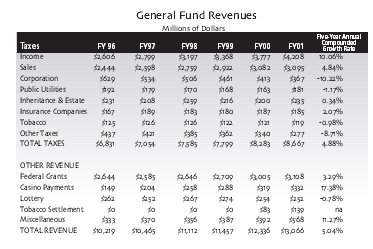
General Fund Expenditures:
- In Fiscal Year 2001, General Fund spending increased by $640 million or
5.2 percent over last fiscal year.
- For the fourth straight year the state's constitutional cap on spending
was lifted under provisions of law. The additional spending required a
declaration of extraordinary circumstances by the Governor. Over the past
four fiscal years the cap has been lifted in order to permit over $1.5
billion in additional state spending.
- Increases above the average growth rate of 5.2 percent for Fiscal Year
2001 occurred in education, health and hospitals, judicial programs and
general administration; below average growth occurred in human services and
regulation and conservation programs. Looking at growth rates over the
five-year period prior to Fiscal Year 2001, the only areas to experience
annual growth rates of less than 5 percent were human services and
education.
- Over the past five fiscal years, General Fund spending has increased at a
compounded annual rate of 5.43 percent.
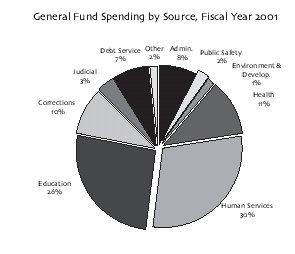
- Two-thirds of all General Fund spending is directed to education, health,
and human services programs. These program areas include education grants to
towns, higher education institutions, mental health and mental retardation
services, nursing homes, income support and health insurance for disabled
and low-income individuals.
Beyond The General Fund - Total Governmental Operations
The state undertakes various activities that do not appear in the General
Fund. These activities include transportation and housing programs, grants to
municipalities for school construction and other needs, loan programs and other
services. When these activities are combined with those of the General Fund, a
more complete picture of state governmental operations emerges.
- Combined governmental operating results for Fiscal Year 2001 show a
deficit of $505 million. On a positive note, this is an improvement of $110
million from the prior fiscal year.
- Operating deficits of $417 million were incurred in the grants and loan
programs and housing programs. The shortfalls must be covered through debt
financing. Issuing bonds to cover annual grants, loans and housing programs
that have become a part of ongoing state operations is a dubious financial
practice. As can be seen from the debt section that follows, controlling
state borrowing is a major challenge facing government.
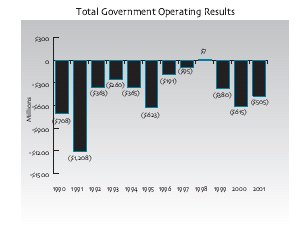
Cumulative Financial Position of the State -The Balance Sheet
In evaluating the state's fiscal health, there is a tendency to focus
exclusively on a single year of state operations. This approach fails to provide
a long-term view of the state's financial position. The balance sheet provides
this perspective. The balance sheet shows total state assets, liabilities, and
fund balances at the close of each fiscal year.
- At the end of Fiscal Year 2001, the General Fund balance sheet displayed a
cumulative GAAP deficit of $782 million. This represents a $107 million
increase over last year.
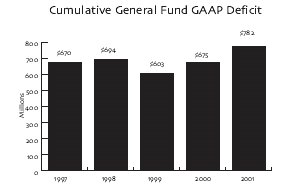
- The main reason for the balance sheet deficit is the state's continued
reliance on an unusual system of budgeting. The state's modified cash
accounting system that is used for budgeting purposes allows some revenues
to be counted before they are earned while some expenditures are not counted
for months after the liability arises. When GAAP corrections to the assets
and liabilities are made a deficit results.
- The GAAP deficit is an important number because those who invest in
Connecticut's bonds and notes review it. If the state's GAAP deficit is
perceived to present investment risk, the interest payments on the debt will
rise costing state taxpayers millions of dollars more.
- The way to improve the state's balance sheet position is clear: adopt GAAP
as the legal basis for state budgeting.
Debt Position
- Connecticut continues to lead the nation in state tax supported debt per
capita. Bonded debt per capita has more than doubled over the past decade
growing to $2,994 at the end of Fiscal Year 2001. This is the amount of
money that every man, women and child would have to pay to eliminate the
state's outstanding debt.
- In Fiscal Year 2001, the state added an additional $503 million to its net
outstanding bonded debt total. Net state bonded debt rose to $10.3 billion
by the end of Fiscal Year 2001.
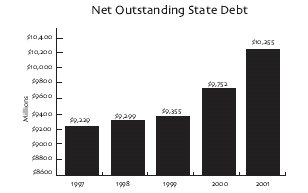
- In Fiscal Year 2001, the state issued $1.327 billion in new debt. Of this
total $816 million was for infrastructure or other assets benefiting future
generations of taxpayers. The remaining $511 million was used to fund
on-going state operating expenses. Bonding for special projects that provide
tangible benefits to future generations is justifiable; bonding for ongoing
programs that should be considered part of normal government operating
expenses is not sound fiscal policy.
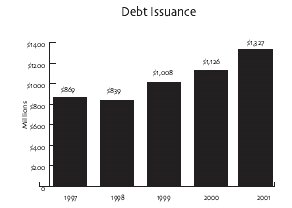
- Large amounts of debt require high annual debt service (principal and
interest) payments. In Fiscal Year 2001, debt service payments totaled $1.34
billion with $790 million paid toward principal and $550 million in interest
payments.
- Debt service is a fixed cost that cannot be quickly adjusted when state
revenue growth slows and budget deficits are projected. In difficult
economic times a high debt load can cripple a state's ability to respond
effectively to the fiscal challenges it faces.
- Bonded debt represents about 60 percent of the state's total long-term
debt obligations. In Fiscal Year 2001, state long-term debt obligations
totaled $17.52 billion.
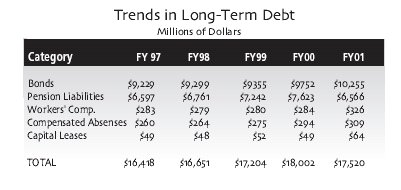
- The decline in total long-term debt since Fiscal Year 2000 is largely due
to exceptional earnings on assets in the pension funds thus reducing the
difference between the amount ultimately payable to employees and the assets
on hand to meet those payments. This difference is known as the unfunded
pension liability.
Population Trends
- Census figures show Connecticut's population grew from 3,287,116 in 1990
to 3,405,565 by the year 2000.
- Connecticut's modest 3.6 percent population gain was the fourth lowest
among all states. Only North Dakota, West Virginia and Pennsylvania had
lower population growth rates during the last decade.
- One result of Connecticut's low population growth was its loss of a
congressional seat. Since the apportionment from the 1930 census,
Connecticut has had six seats in the House of Representatives. Connecticut
will now send only five members to the House.
- Connecticut's population has aged over the last decade. The median age for
state residents increased from 34.4 in 1990 to 37.4 in 2000. The country
showed a similar trend but for a somewhat younger population; the national
median age increased from 32.9 in 1990 to 35.3 in 2000.
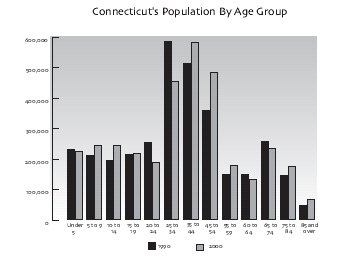
- The state's younger population -- 19 and under -- grew at a faster rate
than its elderly -- those 65 and over. However, a significant upward shift
in age within the large population group from 20 to 65 accounted in large
measure for the rise in Connecticut's median age.
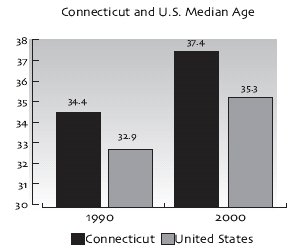
- Connecticut growing racial and ethnic diversity is also reflected in the
2000 census. All racial categories of the non-white population have
increased. The Hispanic or Latino population, which can be of any race, has
also increased.

- Four of Connecticut's five largest cities, those with over 100,000
residents, experienced a population decline during the last decade.
Bridgeport, Hartford, New Haven and Waterbury had an average population loss
of 5.5 percent.
- Of the largest cities, only Stamford showed a population increase of 8.4
percent. Many of the state's smaller communities experienced the largest
growth rate. Fifty-eight Connecticut towns grew by more than 10 percent last
decade. Their average population was 10,300 in 1990 and 11,900 in 2000.
Health Coverage:
Economic Downturn May Erode Recent Health Coverage Gains
In the past several years Connecticut has experienced a decline in the
percentage of residents who lack health insurance. This trend has largely been
due to a strong state economy and low levels of unemployment. Until recently,
Connecticut's tight labor market encouraged more employers to offer health
benefits to help attract and retain qualified workers.
- When measuring the uninsured population, health care analysts often focus
on the non-elderly population (those under age 65) since virtually everyone
age 65 and above is covered by Medicare.
- Using this approach, the Employee Benefit Research Institute estimated
that 9.3 percent of Connecticut's non-elderly population was uninsured in
2000 compared to 11.3 percent in 1999.
- Connecticut's rate of non-elderly uninsured residents (9.3 percent) was
lower than both the national average (15.8 percent) and New England regional
average (10.2 percent).

- However, two of the six New England states fared better than Connecticut
on this measure - Rhode Island at 6.9 percent and New Hampshire at 7.8
percent uninsured.

- Most non-elderly Americans receive their health coverage through the
workplace - either their own employer or a family member's. The rest with
insurance are covered either through public programs, including Medicaid, or
by purchasing coverage as individuals in the private marketplace.
- Connecticut residents have traditionally relied even more heavily on
employer-based coverage than the New England region or the nation as a
whole. As the accompanying table indicates, that trend continued in 2000.

Health policy analysts are predicting a rise in the uninsured population in
the near term, based primarily on the convergence of two trends. The first is
the weakening economy, both on the state and national levels. The current
recession has produced a significant increase in the jobless rate. Studies of
past recessions have shown that the loss of a job often means losing health
coverage.
The second trend is rising health care costs. Medical inflation has been
increasing sharply in recent years after a period of relative stability in the
mid 1990s. As health benefits get more expensive, employers tend to shift more
of the cost onto employees and some may stop offering coverage altogether. For
their part, workers - especially low wage earners - are less likely to accept
offers of coverage when costs rise because they cannot afford the employee
portion of the insurance premium.
A recent survey by the human resource consulting firm William M. Mercer
indicates that health benefit costs continued to increase for employers in 2001
and show no sign of slowing. More than 2,800 employers participated in the
firm's nationwide survey and the following are among the findings:
- The average cost of health benefits rose 11.2 percent in 2001 for
employers with ten or more workers. This increase, which comes after an 8.1
percent rise in 2000, compares to a 2.1 percent general rate of inflation.
- The forecast for 2002 is no better. Employers expect their health benefit
costs to rise by an average of 12.7 percent, with some predicting increases
of 20 percent or more.
- In 2001, smaller employers began shifting more costs onto their workers.
In 2002, it appears large employers will do so as well. Forty percent of
large employers responded that they would require workers to pay a higher
percentage of the total cost in the upcoming year.
- Health benefit costs varied widely by region. In 2001, the overall average
cost per employee was highest in the Northeast ($5,469), followed by the
Midwest ($5,088), the South ($4,643) and the West ($4,538).
Despite the recent decline in Connecticut's uninsured population, many state
residents still lack health coverage and the vast majority are from working
families. In addition, the downturn in the economy and rising health costs will
likely erode health coverage levels in the near future.
Index of Comptroller's
Reports | Comptroller's Home
Page
![]()

